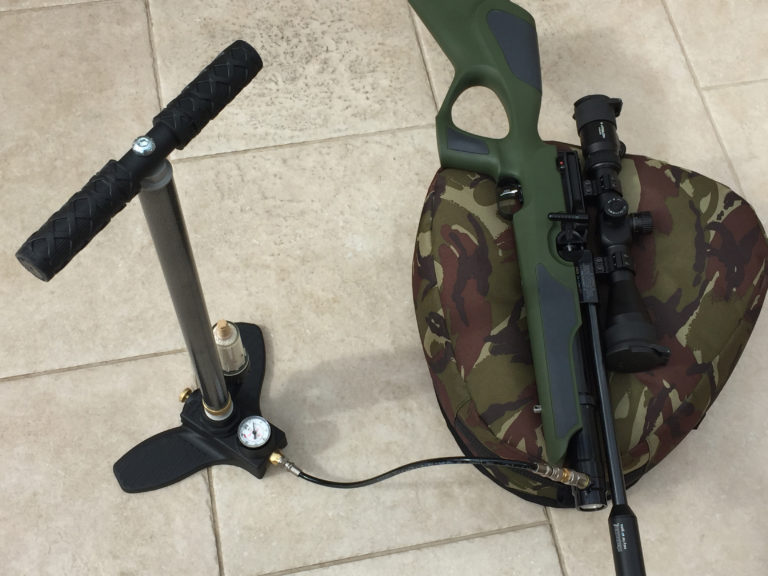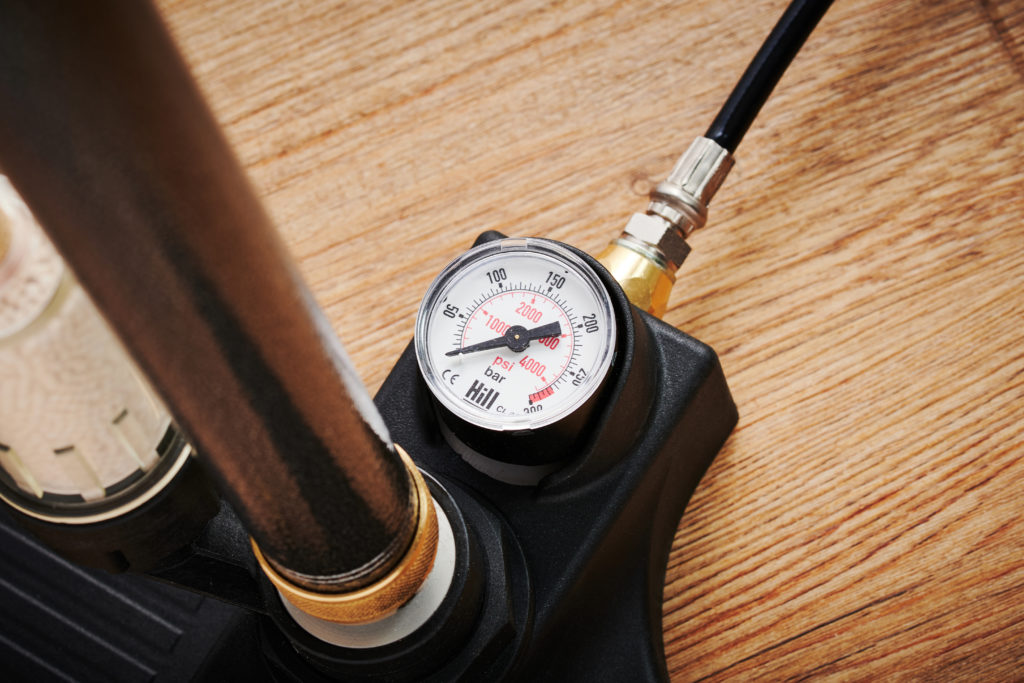Win CENS ProFlex DX5 earplugs worth £1,149 – enter here
The Hill Air Pump MK4

Few shooters would argue that when it comes to filling a PCP with compressed air, the simplest way is to decant it from a main charging cylinder, which makes the Hill Air Pump MK4 such a great piece of kit.
But this type of equipment can be expensive and is quite heavy, and unless you have a compressor of your own you’ll need to take it to a dive shop or gun shop for a refill when the pressure drops too low. But there’s another way – using a stirrup pump like The Hill Air Pump.
Who would want a pump? Well, some shooters won’t even bother with a main charging cylinder and will head straight to one of these for reasons of cost and convenience, while others will use one as a standby when they have no way of getting their main cylinder refilled.
The Hill Air Pump MK4: specification

Pump supplied by: John Rothery (Wholesale) (www.bisley-uk.com)
Manufacturer: Hill Pumps
Model: MK4
Price: Pump only: £149.99, Dry-Pac only: £27.80, Pump and Dry-Pac combo: £169.99
Hose connection: Standard 1/8” BSP
But because a pump is so portable it can also be taken to the field or range where it can be used to top up a gun during a lull in the action so shooting can carry on for as long as you want.
Sheffield-based Hill is probably the best known airgun pump manufacturer, and the latest version on test here is the MK4. It comes flat-packed, but needs only minimal assembly and the only tool you’ll need to put it together is a 14mm spanner or adjustable wrench.
Hill makes an accessory called the Dry-Pac Kit, which helps remove moisture from the air before it gets pumped into your gun. This kit can be bought separately and retro-fitted, or purchased together with the pump as a £169.99 combo, and although optional, I’d recommend using it.
The pump itself feels very solid, with the outer barrel having been given a handsome dark grey speckled finish. The grey inner shaft has a perfectly smooth finish and comes pre-lubed with silicone grease.
This shaft needs to be re-lubricated every three months, and a 15g tube of grease is included with the pump. Some components, such as the base plate and lock ring, are made of an ABS-type black plastic, but these all feel very robust, while the metal handle is capped by two heavily textured soft rubber grips.
When hooking up your rifle, keep the hose as straight as possible to help airflow and reduce stress on the hose. The hose on this pump is just under 46cm (18”) long, and is a bit shorter than I’d have liked and I had to get a little creative with the way I positioned some of the rifles I filled, depending on the location and orientation of the fill ports.
With the pump connected to the gun, it’s just a case of tightening the bleed screw at the back of the pump block by hand, and then you can start pumping.
The Hill manual explains to adopt a comfortable and balanced stance, keeping your back straight, bending your knees slightly and applying long, steady strokes. This is excellent advice as it’s tempting to take short, sharp strokes when resistance starts to build up, while a longer, more deliberate stroke is far more efficient.
Most pre-charged pneumatic airguns have a standard working pressure of between 200 and 230 bar, but there are some guns that can be filled even higher, and the Hill MK4 is rated up to 300 bar. Now we get to the crux of the matter – just how hard is it to fill an airgun using this pump?

The gauge is clear to read, displaying the pressure in bar on the outer ring and pounds per square inch on the inner ring
I’ll be honest and admit that the MK4 did offer me a bit of a physical workout. Shooters who aren’t reasonably fit may well struggle, although the successful use of this pump is as much down to correct technique as sheer physical effort.
I found it relatively easy to pump my guns up to 200 bar, but it got progressively harder beyond this point. However, this is purely down to the effort that is required to generate the high pressures demanded by a PCP rather than any fault of the pump itself.
After getting into the rhythm, I was able to fill one of the guns as high as its recommended working pressure of 250 bar. In contrast, the tyres on my mountain bike get filled to 30 psi – less than 2.1 bar – and I was amazed at the very high pressures this pump can deliver.
The pump is smooth to use throughout each fill, and always feels very sturdy, but it does get fairly warm with prolonged use, so I found it best
to let it completely cool down after filling one rifle before trying to use it to fill another.
The pressure gauge is graduated in both bar and pounds per square inch, bar being shown in black on the outer ring, and psi in red on the inner ring. It would have been nice to have had a pointer which you could turn to your desired fill pressure, making it easier to see when you’ve reached your mark, but the gauge is clear enough to read. It looks to be well calibrated too.
Two of the guns I filled, a Pulsar and Red Wolf, have electronic display screens that indicate the onboard air pressure, and in both cases the readings on the pump’s gauge perfectly matched the readings on the screens.
I’ve been using the pump on a daily basis for the past few weeks, and can honestly say that while the filling process isn’t for couch potatoes, it definitely feels much easier than it did when I started out. This is almost certainly down to me adopting a better technique, but I may actually be getting a little fitter into the bargain!
I have a 12 litre charging cylinder, but even though I have this source of compressed air on tap, I haven’t used it lately because I think I’ve become addicted to the Hill Air Pump. And when I’m able to get back to my gun club I’ll be able to take the pump with me.
That way I won’t need to be quite so careful about rationing the number of shots I take as there’ll be an inexhaustible supply of free air just waiting for me in the boot of my car.
Related Articles
Get the latest news delivered direct to your door
Subscribe to Shooting Times & Country
Discover the ultimate companion for field sports enthusiasts with Shooting Times & Country Magazine, the UK’s leading weekly publication that has been at the forefront of shooting culture since 1882. Subscribers gain access to expert tips, comprehensive gear reviews, seasonal advice and a vibrant community of like-minded shooters.
Save on shop price when you subscribe with weekly issues featuring in-depth articles on gundog training, exclusive member offers and access to the digital back issue library. A Shooting Times & Country subscription is more than a magazine, don’t just read about the countryside; immerse yourself in its most authoritative and engaging publication.







